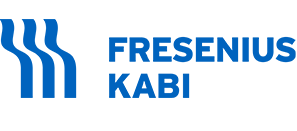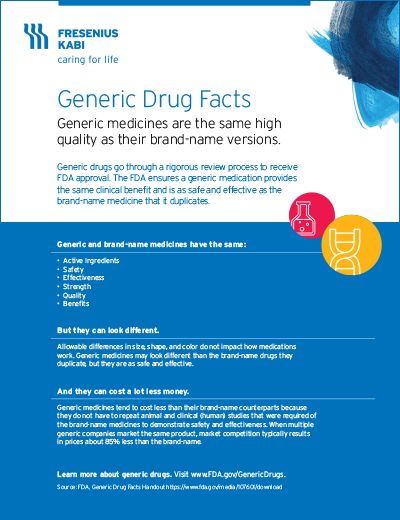Why Generics
Generic Drug Facts
Generic drugs are the same high quality as their brand-name versions.
Generic drugs go through a rigorous review process to receive FDA approval. The FDA ensures a generic medication provides the same clinical benefit and is as safe and effective as the brand-name medicine.
Generic and brand-name drugs have the same:
To learn more about generic drugs visit: www.FDA.gov/genericdrugs
Source: FDA, Generic Drug Facts Handout http://www.fda.gov.media/107601/download
Generic Drug Facts Brochure
Download
Generic Drug FAQs
Frequently Asked Questions about Generic Drugs
Generic contrast agents are considered generic drugs.
A generic drug is a medication created to be the same as a brand-name drug in intended use, dosage form, safety, strength, route of administration, performance characteristics and quality. A generic drug contains the same active ingredients as the brand-name drug. According to the FDA, a generic drug works in the same way and provides the same clinical benefit as the brand-name drug.
A generic medicine must perform the same in the body as the brand-name medicine – this is called bioequivalence. It must be the same as a brand-name medicine in dosage form and route of administration, safety, effectiveness, strength, and labeling (with certain limited exceptions). This standard applies to all generic medicines.
The FDA Generic Drugs Program conducts a rigorous review to ensure generic medicines meet these standards. The FDA also conducts inspections of manufacturing plants and monitors drug safety after the generic medicine has been approved and brought to market.
Generic drugs tend to cost less than their brand-name counterparts because generic drug applicants do not have to repeat animal and clinical (human) studies that were required of the brand-name medicines to demonstrate safety and effectiveness. Still, generic drugs are approved only after a rigorous review by the FDA.
The reduction in upfront research costs means that, although generic medicines have the same therapeutic effect as their branded counterparts, they are typically sold at substantial discounts compared with the price of the brand-name medicine. When multiple generic companies are approved to market a single product, more competition exists in the marketplace, which typically results in lower prices for patients.
To market a generic drug that is the same as (or bioequivalent to) the brand product, drug companies must submit an abbreviated new drug application (ANDA) to the FDA for approval. FDA reviews the application to ensure drug companies have demonstrated that the generic medicine can be substituted for the brand-name medicine that it copies.
An ANDA must show the generic medicine is equivalent to the brand in the following ways:
- Pharmaceutical Equivalence: Documentation from the generic manufacturer are reviewed by the FDA to demonstrate that:
a) The generic drug has the same active ingredient(s) as the brand-name drug.
b) The generic drug has the same dosage form as the brand-name drug.
c) The generic drug has the same strength and route of administration as the brand-name drug.
d) The generic drug has the same indications as the brand-name drug.
e) The inactive ingredients of the generic drug are acceptable and don’t change how the drug works.
f) The generic drug has similar stability through shelf life as the brand name drug. - Bioequivalence: Comparisons—often in human volunteers who take both the generic and brand-name drugs—ensure that:
a) The generic drug performs the same in the human body as the brand-name drug.
b) The generic drug is as safe and effective as the brand-name drug. - Appropriate Container and Labeling: FDA inspection of the container and labeling demonstrates that:
a) The generic drug’s label is the same as the brand-name drug’s label, with some exceptions—such as indications protected by patents or exclusivity.
b) The generic drug is sold and shipped in an appropriate container. - Appropriate Manufacturing:
a) The generic drug meets the same requirements for identity, strength, purity, and quality as the brand-name drug.
b) The manufacturer is capable of making the generic drug correctly and consistently.
The ANDA process does not, however, require the drug applicant to repeat costly animal and clinical (human) studies on ingredients or dosage forms already approved for safety and effectiveness. This allows generic medicines to be brought to market more quickly and at lower cost, allowing for increased access to medications by the public.
For more information, you can:
• Visit the FDA Generic Drugs Program
• Call 1-888-INFO-FDA
1. FDA’s Frequently Asked Questions on Generic Drugs, https://www.fda.gov/drugs/questions-answers/generic-drugs-questions-answers, content current as of 03/16/2021. Accessed March 2022.
2. FDA’s What Makes a Generic the Same as a Brand-Name Drug, https://www.fda.gov/media/111058/download. Accessed March 2022.


